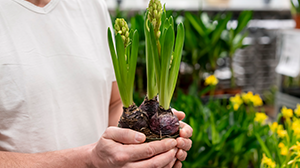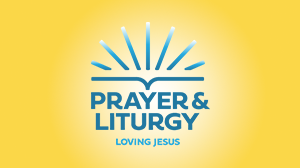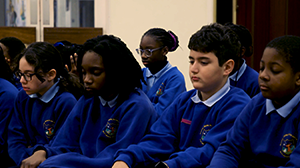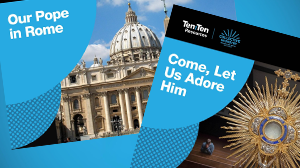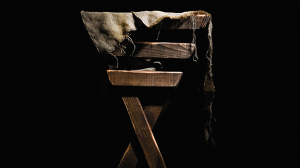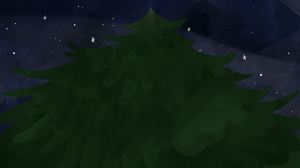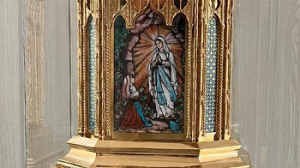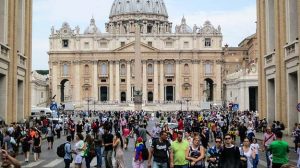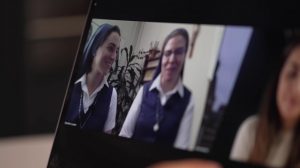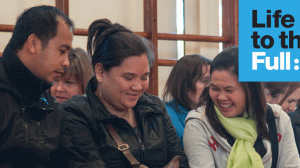
This month, our Ten Ten Year of Pilgrimage takes us into the wilderness. Imagine the scene. A dry, rocky landscape, largely uninhabited, where rainfall is minimal. With bright sun and little shelter, the days are hot and the nights, cold. On occasion, there are sandstorms, and visibility can be poor.
Where are we? We are with Jesus in the desert – it’s the season of Lent.
After His baptism, Jesus, like a first century Bear Grylls, was led by the Spirit into the wilderness. It would have been a testing time, roughing it in the worst conditions, alone and with little in the way of supplies.
The Church’s invitation to enter this season may seem strange. Why would we purposefully put ourselves in the way of discomfort? It seems counterintuitive. What is the point?
As disciples of Jesus, we are called to emulate Jesus, His choices, words and actions, and Lent is an extraordinary opportunity to do just that. But how?
In the gospel reading on Ash Wednesday, the first day of Lent, Jesus speaks about prayer, fasting and almsgiving.
Prayer – Look to God
Our lives are noisy. Our mobile phones, work, family and responsibilities demand our attention constantly. So, there are challenges to carving out time for prayer. Even when we find a peaceful moment, we may find a hundred intrusive thoughts racing through our minds. Prayer can be a battle.
Around the fifth century, the Desert Fathers and Mothers practised a Lent-style life, full-time. They retreated to the outskirts of the cities and into the Deserts of Egypt, Syria and Palestine to find a different way of being a Christian in the world. Their holiness was admired and their wisdom sought. Desert Mother, Syncletica of Alexandria shares her wisdom on prayer:
Being alone in a quiet place with God can sometimes seem like a waste of time, but time is never wasted when it’s spent with God. It may not seem to achieve anything, yet time spent with someone is the way we get to know them. Prayer is entering into a friendship with God.
Inevitably, looking to God confronts us with ourselves (which bridges us to the next pillar of Lent, Fasting – see below). Spending time with the perfect one shines a light on both how loved we are and how there is room to grow to be more like God.
One way of reflecting on ourselves during the penitential season of Lent is by examining our consciences. An Examination of Conscience is a traditional prayerful practice associated with preparing for the Sacrament of Reconciliation.
Another common way to pray during Lent is to reflect on the Stations of the Cross. The fourteen prayer ‘stations’ reflect fourteen significant ‘stopping places’ on Jesus’ pilgrimage to the cross. If you are a subscriber to our Collective Worship resources, you may like to use our Stations of the Cross resource to pray the stations with the children in your school.

Stations of the Cross
This resource provides you with guidance for creating your own reflections on the Stations of the Cross with children.
Go to PrayerFasting – Look to Ourselves
A familiar question as Lent approaches is, ‘What are you giving up for Lent?’
Today, fasting might be more associated with diets that include fasting certain food types, such as the 5:2 Diet. But the concept of fasting is an old one. Eating pancakes on Shrove Tuesday became popular as larders were cleared of ‘rich ingredients’ before Lent began.
Fasting during Lent is not about losing weight or having a healthier body – though that might be a happy by-product! It’s not all about food either. All sorts of things can be fasted: electronics, activities, social media, anything really.
Fasting changes our habits and perspective. Doing without something not only increases our self-control, but also helps us to see things from the perspective of others and to stand with them in solidarity.
Fasting is a form of penance. As said before, spending time with God in prayer, alerts us to our own shortcomings. Rather than running from God, which might be our temptation, we can run to Him, knowing that He is merciful and compassionate. Fasting shows our sorrow for sin and our commitment to making a change for the better.
Look to Others – Almsgiving
Prayer and fasting lead to almsgiving. Almsgiving is an act of kindness but also a spiritual practice. Donating money, food or clothes to those who are in need is good for both the recipient and the giver because freely giving away our possessions loosens their grip on us, helping us trust that God will provide. This is love in action.
St Teresa of Calcutta explains the link between prayer and almsgiving beautifully:
This, she pointed out, ‘is why so much assistance falls into the void. It doesn’t change anything. It doesn’t contribute anything because it doesn’t bring love and it isn’t born of prayer.’
Growth in the Desert
The three spiritual practices of prayer, fasting and almsgiving go together:
- Prayer opens our heart to the love of God for ourselves and our neighbour.
- Fasting frees up time and money that can be given away.
- Almsgiving honours God by seeing the intrinsic worth of His people and acting in love, to change their situation for the better.
In the stark landscape of Lent, where self-denial can be the first thing we see, the joy that Amma Syncletica speaks of can be found on the journey. Seemingly from nowhere, a crack on the desert floor can reveal a beautiful flower.
Last month we began our Ten Ten Year of Pilgrimage recognising that the ultimate destination of our earthly pilgrimage is heaven. So, how does our pilgrimage through Lent help us towards that destination? In the hardships and self-denial, we can discover the key to great riches. We are brought to the source of our salvation: the cross. Through His death and resurrection, Jesus is THE WAY to heaven.

Ten Ten Year of Pilgrimage
Over the past 18 months, the journeys that we might normally have made have often been thwarted…
Go to Content

